Flood Susceptibility Assessment Based on the Analytical Hierarchy Process (AHP) and Geographic Information Systems (GIS): A Case Study of the Broader Area of Megala Kalyvia, Thessaly, Greece
Abstract
1. Introduction
2. Study Area
2.1. Location and Characteristics
2.2. Overview of Recent Flood Events
3. Materials and Methods
3.1. Data Collection and Analysis
3.2. Methodology
3.3. Factors Affecting the Flood Susceptibility
3.3.1. Distance from Rivers and Channels
3.3.2. Distance from Confluences of Rivers or Channels
3.3.3. Drainage Density
3.3.4. Distance from Intersections Between Channels or Channels and Roads
3.3.5. Land Use and Land Cover
3.3.6. Slope and Elevation
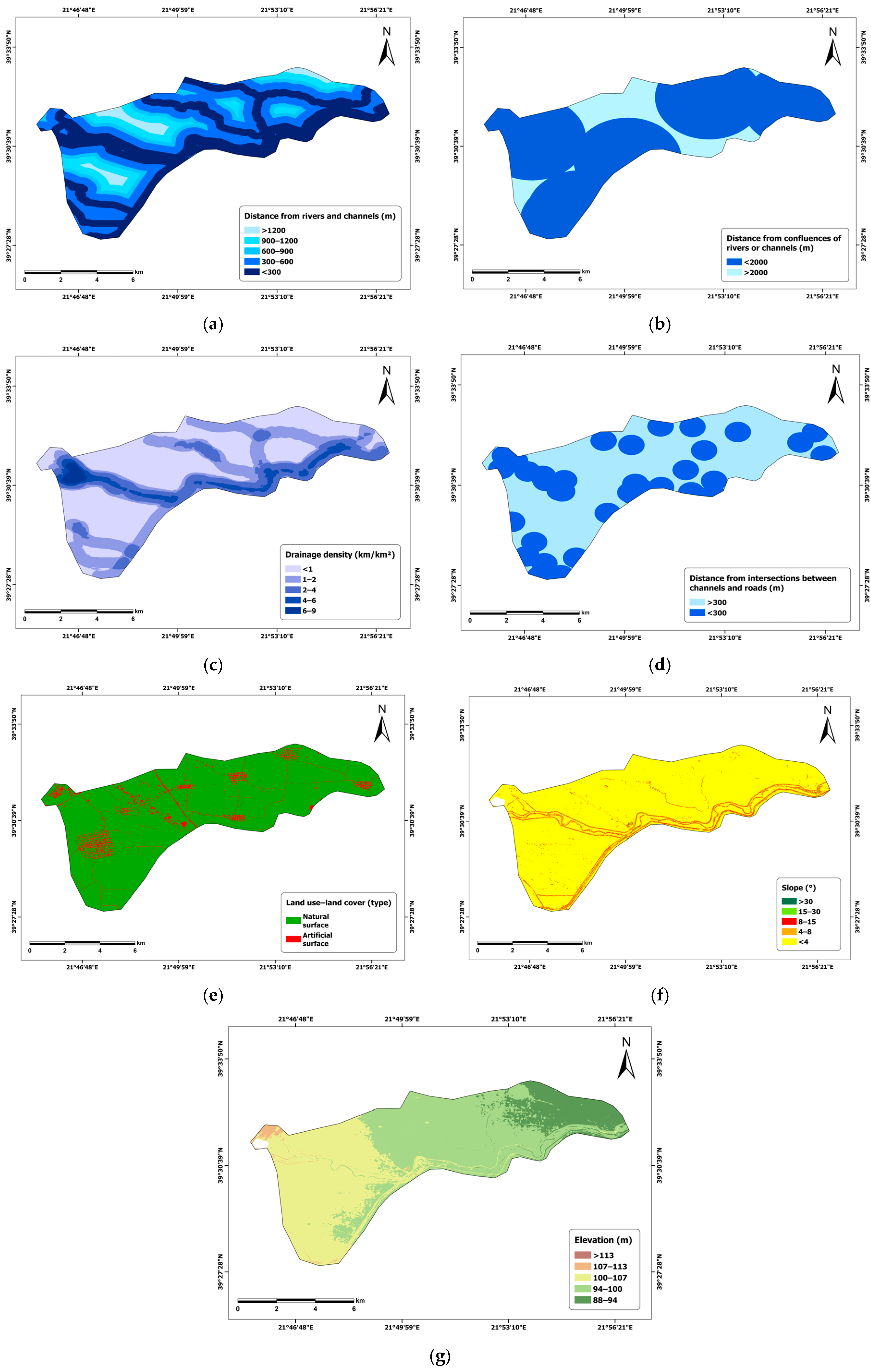
3.4. Pairwise Comparison Matrix
4. Results
4.1. Pairwise Comparison Matrix Normalization and Criterion Weighting Factor Calculation
- We divided the sum of each column by the value assigned to each cell of the comparison table to obtain the normalized value of each cell.
- The sum of each row (CA) of the normalized pairwise comparison matrix was calculated.
- The value of λ was found by summing the CA column through the following equation:
- The consistency index (CI) was calculated with Equation (1).
- The consistency ratio (CR) was calculated with Equation (2), while the value of R is 1.32 when the total number of criteria (n) is 7, based on Table 3 [53]. Since the value of CR is 0.047, making CR < 0.1, the weighting factor for each category of the criteria that was calculated in the pairwise comparison table is considered consistent [57].
- The weighting factor (wi) of each criterion was developed by calculating the average of the rows of each cell (Cw) with the following equation:
4.2. Calculation of the Final Value Index
4.3. Flood Susceptibility Assessment Map in the Study Area

4.4. Comparison Between the Flood Susceptibility Assessment Map and the Flood Events in 2018, 2020, and 2023
4.5. Inundation Height of Sites Visited Within the Study Area Through 2−5 November 2023
5. Discussion
5.1. Comparison with Similar Studies and Methodologies
5.2. Limitations of the Present Study
6. Conclusions
Author Contributions
Funding
Data Availability Statement
Conflicts of Interest
References
- Li, Y.; Zhang, Q.; Cai, Y.; Tan, Z.; Wu, H.; Liu, X.; Yao, J. Hydrodynamic Investigation of Surface Hydrological Connectivity and Its Effects on the Water Quality of Seasonal Lakes: Insights from a Complex Floodplain Setting (Poyang Lake, China). Sci. Total Environ. 2019, 660, 245–259. [Google Scholar] [CrossRef]
- Hamilton, S.K. Flood Plains of Large Rivers. In Encyclopedia of Inland Waters, 2nd ed.; Mehner, T., Tockner, K., Eds.; Elsevier: Oxford, UK, 2022; pp. 290–300. ISBN 978-0-12-822041-2. [Google Scholar]
- Singha, P.; Pal, S. Wetland Transformation and Its Impact on the Livelihood of the Fishing Community in a Flood Plain River Basin of India. Sci. Total Environ. 2023, 858, 159547. [Google Scholar] [CrossRef] [PubMed]
- Viero, D.P.; Roder, G.; Matticchio, B.; Defina, A.; Tarolli, P. Floods, Landscape Modifications and Population Dynamics in Anthropogenic Coastal Lowlands: The Polesine (Northern Italy) Case Study. Sci. Total Environ. 2019, 651, 1435–1450. [Google Scholar] [CrossRef] [PubMed]
- Roccati, A.; Luino, F.; Turconi, L.; Piana, P.; Watkins, C.; Faccini, F. Historical Geomorphological Research of a Ligurian Coastal Floodplain (Italy) and Its Value for Management of Flood Risk and Environmental Sustainability. Sustainability 2018, 10, 3727. [Google Scholar] [CrossRef]
- Orengo, H.A.; Krahtopoulou, A.; Garcia-Molsosa, A.; Palaiochoritis, K.; Stamati, A. Photogrammetric Re-Discovery of the Hidden Long-Term Landscapes of Western Thessaly, Central Greece. J. Archaeol. Sci. 2015, 64, 100–109. [Google Scholar] [CrossRef]
- Zekkos, D.; Zalachoris, G.; Alvertos, A.E.; Amatya, P.M.; Blunts, P.; Marin, C.; Dafis, S.; Farmakis, I.; Athanassios, G.; Madeline, H.; et al. The September 18–20 2020 Medicane Ianos Impact on Greece Phase I Reconnaissance Report. 2020. Available online: https://ntrs.nasa.gov/api/citations/20205011398/downloads/Medicane%20Ianos%20GEER%20Report.pdf (accessed on 12 February 2024).
- Bathrellos, G.D.; Skilodimou, H.D.; Soukis, K.; Koskeridou, E. Temporal and Spatial Analysis of Flood Occurrences in the Drainage Basin of Pinios River (Thessaly, Central Greece). Land 2018, 7, 106. [Google Scholar] [CrossRef]
- DeVries, B.; Huang, C.; Armston, J.; Huang, W.; Jones, J.W.; Lang, M.W. Rapid and Robust Monitoring of Flood Events Using Sentinel-1 and Landsat Data on the Google Earth Engine. Remote Sens. Environ. 2020, 240, 111664. [Google Scholar] [CrossRef]
- Diakakis, M.; Mavroulis, S.; Deligiannakis, G. Floods in Greece, a Statistical and Spatial Approach. Nat. Hazards 2012, 62, 485–500. [Google Scholar] [CrossRef]
- Copernicus Sentinel-2 Imagery Agricultural Areas Around Thessaly, Greece, Remain Flooded 2023. Available online: https://www.copernicus.eu/en/media/image-day-gallery/agricultural-areas-around-thessaly-greece-remain-flooded (accessed on 3 March 2024).
- Gaki-Papanastassiou, K.; Karymbalis, E.; Maroukian, H. Recent geomorphic changes and anthropogenic activities in the deltaic plain of Pinios river in Central Greece. Bull. Geol. Soc. Greece 2017, 43, 409. [Google Scholar] [CrossRef]
- Farhadi, H.; Esmaeily, A.; Najafzadeh, M. Flood Monitoring by Integration of Remote Sensing Technique and Multi-Criteria Decision Making Method. Comput. Geosci. 2022, 160, 105045. [Google Scholar] [CrossRef]
- Burayu, D.G.; Karuppannan, S.; Shuniye, G. Identifying Flood Vulnerable and Risk Areas Using the Integration of Analytical Hierarchy Process (AHP), GIS, and Remote Sensing: A Case Study of Southern Oromia Region. Urban Clim. 2023, 51, 101640. [Google Scholar] [CrossRef]
- Elsadek, W.M.; Wahba, M.; Al-Arifi, N.; Kanae, S.; El-Rawy, M. Scrutinizing the Performance of GIS-Based Analytical Hierarchical Process Approach and Frequency Ratio Model in Flood Prediction—Case Study of Kakegawa, Japan. Ain Shams Eng. J. 2024, 15, 102453. [Google Scholar] [CrossRef]
- Bruno, L.S.; Mattos, T.S.; Oliveira, P.T.S.; Almagro, A.; Rodrigues, D.B.B. Hydrological and Hydraulic Modeling Applied to Flash Flood Events in a Small Urban Stream. Hydrology 2022, 9, 223. [Google Scholar] [CrossRef]
- El-Bagoury, H.; Gad, A. Integrated Hydrological Modeling for Watershed Analysis, Flood Prediction, and Mitigation Using Meteorological and Morphometric Data, SCS-CN, HEC-HMS/RAS, and QGIS. Water 2024, 16, 356. [Google Scholar] [CrossRef]
- Yu, J.; Liu, D.; Wang, X.; Zhu, J.; Liao, Z.; Cai, J. A Transition Zone Boundary Determining Method Based on MIKE21: A Case Study of Baiyangdian Lake, North China. J. Hydrol. 2024, 638, 131447. [Google Scholar] [CrossRef]
- Varra, G.; Della Morte, R.; Tartaglia, M.; Fiduccia, A.; Zammuto, A.; Agostino, I.; Booth, C.A.; Quinn, N.; Lamond, J.E.; Cozzolino, L. Flood Susceptibility Assessment for Improving the Resilience Capacity of Railway Infrastructure Networks. Water 2024, 16, 2592. [Google Scholar] [CrossRef]
- Maranzoni, A.; D’Oria, M.; Rizzo, C. Quantitative Flood Hazard Assessment Methods: A Review. J. Flood Risk Manag. 2023, 16, e12855. [Google Scholar] [CrossRef]
- Guerri, G.; Crisci, A.; Morabito, M. Urban Microclimate Simulations Based on GIS Data to Mitigate Thermal Hot-Spots: Tree Design Scenarios in an Industrial Area of Florence. Build. Environ. 2023, 245, 110854. [Google Scholar] [CrossRef]
- Topuz, M.; Deniz, M. Application of GIS and AHP for Land Use Suitability Analysis: Case of Demirci District (Turkey). Humanit. Soc. Sci. Commun. 2023, 10, 115. [Google Scholar] [CrossRef]
- Awan, H.H.; Kabdrakhmanova, M.; Varol, H.A.; Karaca, F. A GIS-Based Emergency Response and Management Support Framework for Earthquake Crisis: A Case Study of Antakya and Kahramanmaras Earthquake in Turkey. Int. J. Disaster Risk Reduct. 2024, 111, 104706. [Google Scholar] [CrossRef]
- Niu, H.; Shao, S.; Gao, J.; Jing, H. Research on GIS-Based Information Value Model for Landslide Geological Hazards Prediction in Soil-Rock Contact Zone in Southern Shaanxi. Phys. Chem. Earth Parts A/B/C 2024, 133, 103515. [Google Scholar] [CrossRef]
- Park, H.S.; Kwon, S.A.; Azam, M. A Study on GIS-Based Spatial Analysis of Emergency Response for Disaster Management: Focusing on Seoul. Heliyon 2024, 10, e28669. [Google Scholar] [CrossRef]
- Taiwo, B.E.; Kafy, A.-A.; Samuel, A.A.; Rahaman, Z.A.; Ayowole, O.E.; Shahrier, M.; Duti, B.M.; Rahman, M.T.; Peter, O.T.; Abosede, O.O. Monitoring and Predicting the Influences of Land Use/Land Cover Change on Cropland Characteristics and Drought Severity Using Remote Sensing Techniques. Environ. Sustain. Indic. 2023, 18, 100248. [Google Scholar] [CrossRef]
- Suwanno, P.; Yaibok, C.; Pornbunyanon, T.; Kanjanakul, C.; Buathongkhue, C.; Tsumita, N.; Fukuda, A. GIS-Based Identification and Analysis of Suitable Evacuation Areas and Routes in Flood-Prone Zones of Nakhon Si Thammarat Municipality. IATSS Res. 2023, 47, 416–431. [Google Scholar] [CrossRef]
- Geological Survey Ireland Historic Groundwater Flood Map. Geological Survey Ireland. Available online: https://data.gov.ie/ga/dataset/historic-groundwater-flood-map-120000-ireland-roi-itm (accessed on 19 October 2024).
- Dean, M. Chapter Six—Multi-Criteria Analysis. In Standard Transport Appraisal Methods; Mouter, N., Ed.; Advances in Transport Policy and Planning; Academic Press: Cambridge, MA, USA, 2020; Volume 6, pp. 165–224. [Google Scholar]
- Toosi, A.S.; Calbimonte, G.H.; Nouri, H.; Alaghmand, S. River Basin-Scale Flood Hazard Assessment Using a Modified Multi-Criteria Decision Analysis Approach: A Case Study. J. Hydrol. 2019, 574, 660–671. [Google Scholar] [CrossRef]
- Al-Taani, A.; Al-husban, Y.; Ayan, A. Assessment of Potential Flash Flood Hazards. Concerning Land Use/Land Cover in Aqaba Governorate, Jordan, Using a Multi-Criteria Technique. Egypt. J. Remote Sens. Space Sci. 2023, 26, 17–24. [Google Scholar] [CrossRef]
- Saaty, T.L. The Analytic Hierarchy Process (AHP). J. Oper. Res. Soc. 1980, 41, 1073–1076. [Google Scholar]
- Mokhtari, E.; Farouk, M.; Abdelkebir, B.; Engel, B. Flood Risk Assessment Using Analytical Hierarchy Process: A Case Study from the Cheliff-Ghrib Watershed, Algeria. J. Water Clim. Change 2023, 14, 694–711. [Google Scholar] [CrossRef]
- Wubalem, A.; Tesfaw, G.; Dawit, Z.; Getahun, B.; Mekuria, T.; Jothimani, M. Comparison of Statistical and Analytical Hierarchy Process Methods on Flood Susceptibility Mapping: In a Case Study of the Lake Tana Sub-Basin in Northwestern Ethiopia. Open Geosci. 2021, 13, 1668–1688. [Google Scholar] [CrossRef]
- Gemitzi, A.; Kopsidas, O.; Stefani, F.; Polymeros, A.; Bellos, V. A Constantly Updated Flood Hazard Assessment Tool Using Satellite-Based High-Resolution Land Cover Dataset Within Google Earth Engine. Land 2024, 13, 1929. [Google Scholar] [CrossRef]
- Poeppl, R.E.; Fryirs, K.A.; Tunnicliffe, J.; Brierley, G.J. Managing Sediment (Dis)Connectivity in Fluvial Systems. Sci. Total Environ. 2020, 736, 139627. [Google Scholar] [CrossRef]
- Waseem, M.; Ahmad, S.; Ahmad, I.; Wahab, H.; Leta, M.K. Urban Flood Risk Assessment Using AHP and Geospatial Techniques in Swat Pakistan. SN Appl. Sci. 2023, 5, 215. [Google Scholar] [CrossRef]
- Radhakrishnan, S.; Duraisamy Rajasekaran, S.K.; Sujatha, E.R.; Neelakantan, T.R. A Comparative Study on 2015 and 2023 Chennai Flooding: A Multifactorial Perspective. Water 2024, 16, 2477. [Google Scholar] [CrossRef]
- Sofia, G.; Nikolopoulos, E.I. Floods and Rivers: A Circular Causality Perspective. Sci. Rep. 2020, 10, 5175. [Google Scholar] [CrossRef]
- Kido, R.; Inoue, T.; Hatono, M.; Yamanoi, K. Assessing the Impact of Climate Change on Sediment Discharge Using a Large Ensemble Rainfall Dataset in Pekerebetsu River Basin, Hokkaido. Prog. Earth Planet. Sci. 2023, 10, 54. [Google Scholar] [CrossRef]
- Nkwasa, A.; Chawanda, C.J.; Schlemm, A.; Ekolu, J.; Frieler, K.; van Griensven, A. Historical Climate Impact Attribution of Changes in River Flow and Sediment Loads at Selected Gauging Stations in the Nile Basin. Clim. Change 2024, 177, 42. [Google Scholar] [CrossRef]
- Karamvasis, K.; Karathanassi, V. FLOMPY: An Open-Source Toolbox for Floodwater Mapping Using Sentinel-1 Intensity Time Series. Water 2021, 13, 2943. [Google Scholar] [CrossRef]
- Mavroulis, S.; Mavrouli, M.; Lekkas, E.; Tsakris, A. Impact of the September 2023 Storm Daniel and Subsequent Flooding in Thessaly (Greece) on the Natural and Built Environment and on Infectious Disease Emergence. Environments 2024, 11, 163. [Google Scholar] [CrossRef]
- Dimitriou, E.; Efstratiadis, A.; Zotou, I.; Papadopoulos, A.; Iliopoulou, T.; Sakki, G.-K.; Mazi, K.; Rozos, E.; Koukouvinos, A.; Koussis, A.D.; et al. Post-Analysis of Daniel Extreme Flood Event in Thessaly, Central Greece: Practical Lessons and the Value of State-of-the-Art Water-Monitoring Networks. Water 2024, 16, 980. [Google Scholar] [CrossRef]
- Moraiti, K.; Sigourou, S.; Dimitriadis, P.; Ioannidis, R.; Benekos, I.; Iliopoulou, T.; Kitsou, O.; Mamassis, N.; Koutsoyiannis, D.; Sargentis, G.F. Documenting the Changing Floodplain of Nileas Basin in North Euboea (Greece) before and after Storms Daniel and Elias. Rural Reg. Dev. 2024, 2, 10013. [Google Scholar] [CrossRef]
- Meteosearch Trikala Station (LG57). Available online: https://meteosearch.meteo.gr/data/list-station-files720.cfm (accessed on 10 January 2024).
- Copernicus Emergency Management Service EMSR271: Floods in Central Greece 2018. Available online: https://mapping.emergency.copernicus.eu/activations/EMSR271/ (accessed on 10 January 2024).
- Copernicus Emergency Management Service EMSR465: Floods in Thessaly Region, Greece 2020. Available online: https://emergency.copernicus.eu/mapping/list-of-components/EMSR465 (accessed on 10 January 2024).
- Copernicus Emergency Management Service Flood in Greece—EMSR692—Situational Reporting 2023. Available online: https://rapidmapping.emergency.copernicus.eu/EMSR692/reporting (accessed on 10 January 2024).
- Copernicus Land Monitoring Service CLC+Backbone 2018 (Raster 10 m), Europe, 3-Yearly 2018. Available online: https://land.copernicus.eu/en/products/clc-backbone/clc-backbone-2018 (accessed on 10 January 2024).
- Esri Tabulate Area (Spatial Analyst)—ArcGIS Pro Documentation 2024. Available online: https://pro.arcgis.com/en/pro-app/latest/tool-reference/spatial-analyst/tabulate-area.htm (accessed on 13 May 2024).
- Jemai, S.; Belkendil, A.; Kallel, A.; Ayadi, I. Assessment of Flood Risk Using Hierarchical Analysis Process Method and Remote Sensing Systems through Arid Catchment in Southeastern Tunisia. J. Arid Environ. 2024, 222, 105150. [Google Scholar] [CrossRef]
- Shadmaan, M.S.; Hassan, K.M. Assessment of Flood Susceptibility in Sylhet Using Analytical Hierarchy Process and Geospatial Technique. Geomatica 2024, 76, 100003. [Google Scholar] [CrossRef]
- Aichi, A.; Ikirri, M.; Haddou, M.A.; Quesada-Román, A.; Sahoo, S.; Singha, C.; Sajinkumar, K.S.; Abioui, M. Integrated GIS and Analytic Hierarchy Process for Flood Risk Assessment in the Dades Wadi Watershed (Central High Atlas, Morocco). Results Earth Sci. 2024, 2, 100019. [Google Scholar] [CrossRef]
- Zhang, B.; Zhang, L.; Chen, B.; Deng, L.; Fu, B.; Yan, M.; Ji, C. Assessment of Mangrove Health Based on Pressure–State–Response Framework in Guangxi Beibu Gulf, China. Ecol. Indic. 2024, 167, 112685. [Google Scholar] [CrossRef]
- Koroma, A.O.; Saber, M.; Abdelbaki, C. Urban Flood Vulnerability Assessment in Freetown, Sierra Leone: AHP Approach. Hydrology 2024, 11, 158. [Google Scholar] [CrossRef]
- Cao, X.; Zhang, J.; Meng, H.; Lai, Y.; Xu, M. Remote Sensing Inversion of Water Quality Parameters in the Yellow River Delta. Ecol. Indic. 2023, 155, 110914. [Google Scholar] [CrossRef]
- Moreira, L.L.; de Brito, M.M.; Kobiyama, M. Effects of Different Normalization, Aggregation, and Classification Methods on the Construction of Flood Vulnerability Indexes. Water 2021, 13, 98. [Google Scholar] [CrossRef]
- Vojtek, M.; Vojteková, J. Flood Susceptibility Mapping on a National Scale in Slovakia Using the Analytical Hierarchy Process. Water 2019, 11, 364. [Google Scholar] [CrossRef]
- Bačová Mitková, V.; Halmová, D.; Pekárová, P.; Miklánek, P. The Copula Application for Analysis of the Flood Threat at the River Confluences in the Danube River Basin in Slovakia. Water 2023, 15, 984. [Google Scholar] [CrossRef]
- Pregnolato, M.; Winter, A.O.; Mascarenas, D.; Sen, A.D.; Bates, P.; Motley, M.R. Assessing Flooding Impact to Riverine Bridges: An Integrated Analysis. Nat. Hazards Earth Syst. Sci. 2022, 22, 1559–1576. [Google Scholar] [CrossRef]
- Elhag, M.; Yilmaz, N. Insights of Remote Sensing Data to Surmount Rainfall/Runoff Data Limitations of the Downstream Catchment of Pineios River, Greece. Environ. Earth Sci. 2021, 80, 35. [Google Scholar] [CrossRef]
- Bathrellos, G.D.; Gaki-Papanastassiou, K.; Skilodimou, H.D.; Papanastassiou, D.; Chousianitis, K.G. Potential Suitability for Urban Planning and Industry Development Using Natural Hazard Maps and Geological–Geomorphological Parameters. Environ. Earth Sci. 2012, 66, 537–548. [Google Scholar] [CrossRef]
- Kittipongvises, S.; Phetrak, A.; Rattanapun, P.; Brundiers, K.; Buizer, J.L.; Melnick, R. AHP-GIS Analysis for Flood Hazard Assessment of the Communities Nearby the World Heritage Site on Ayutthaya Island, Thailand. Int. J. Disaster Risk Reduct. 2020, 48, 101612. [Google Scholar] [CrossRef]
- Dash, P.; Sar, J. Identification and Validation of Potential Flood Hazard Area Using GIS -based Multi-criteria Analysis and Satellite Data-derived Water Index. J. Flood Risk Manag. 2020, 13, e12620. [Google Scholar] [CrossRef]

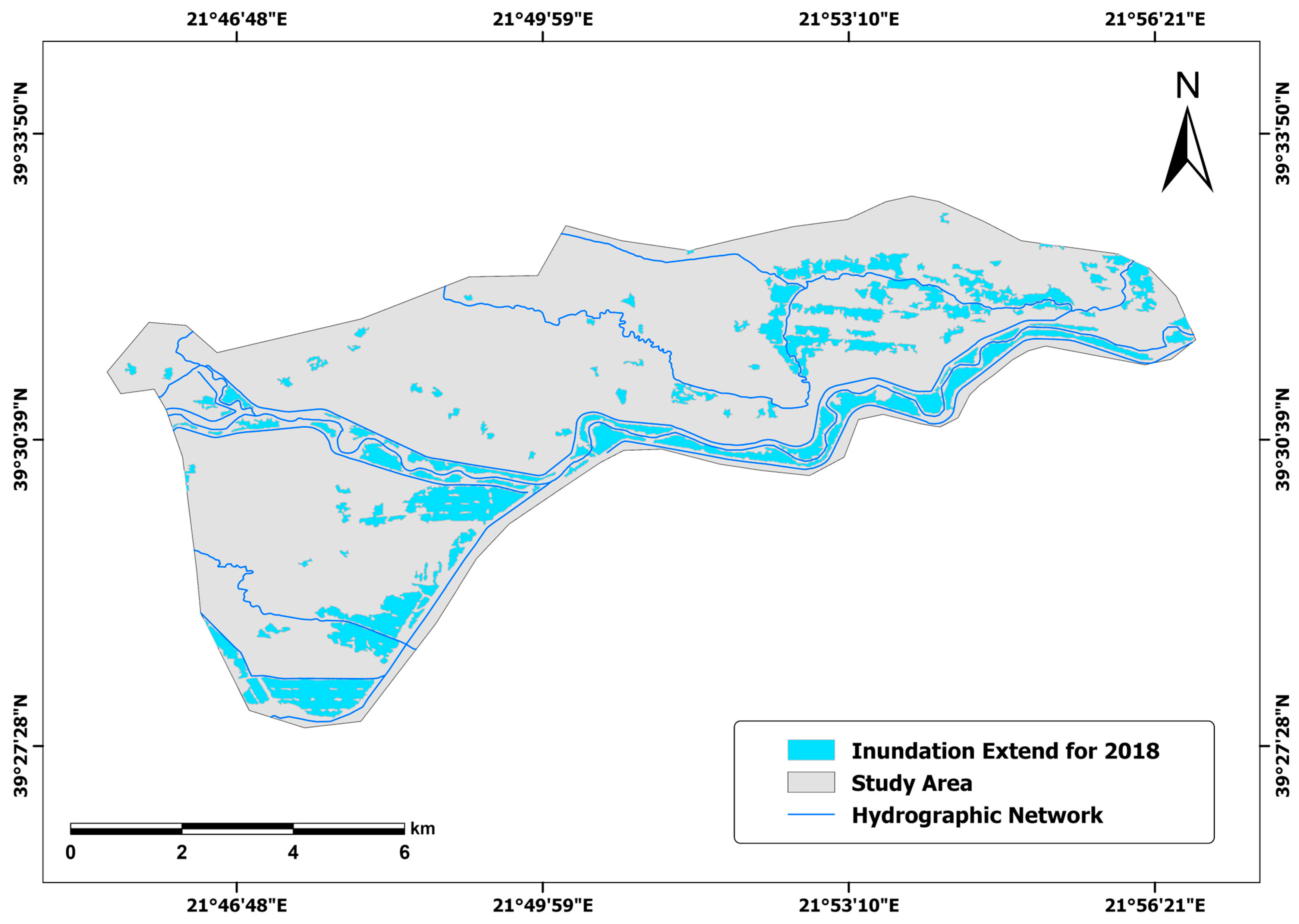
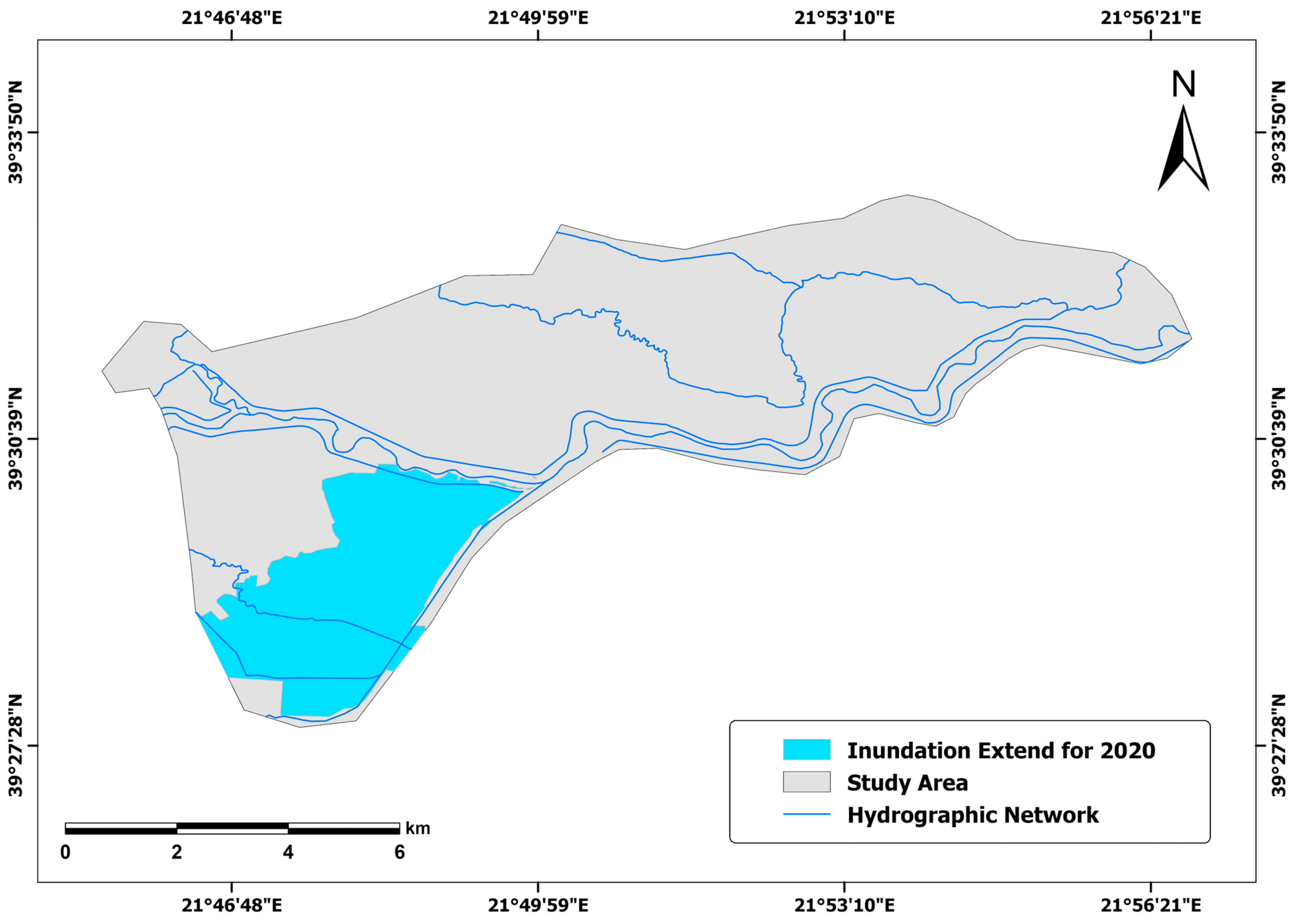
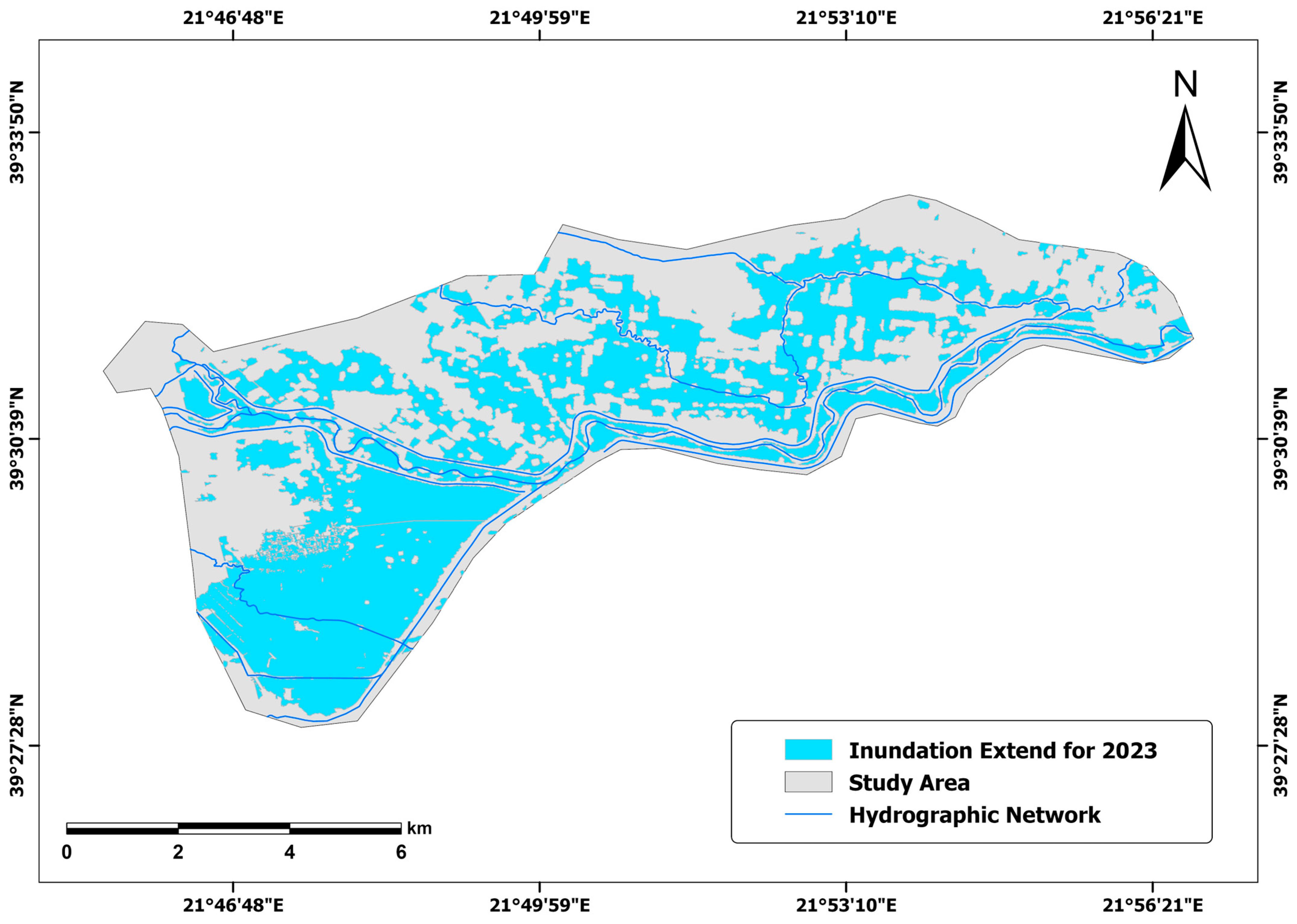
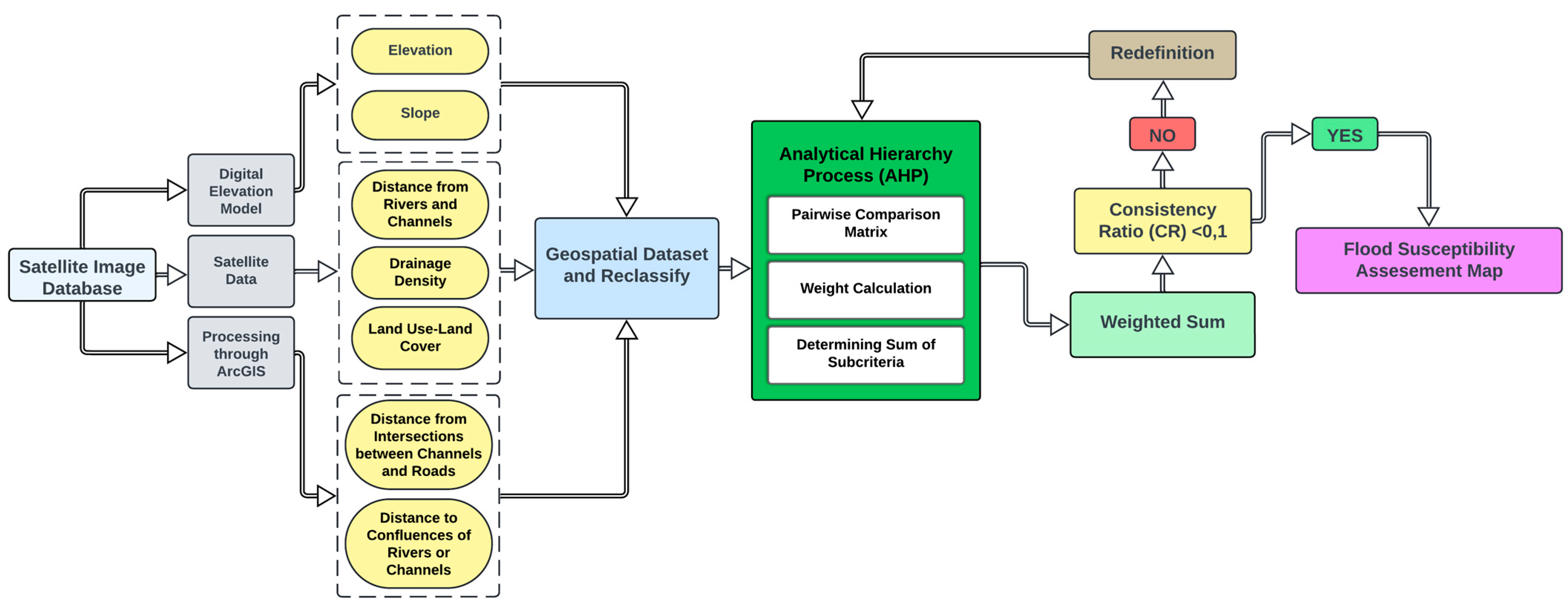
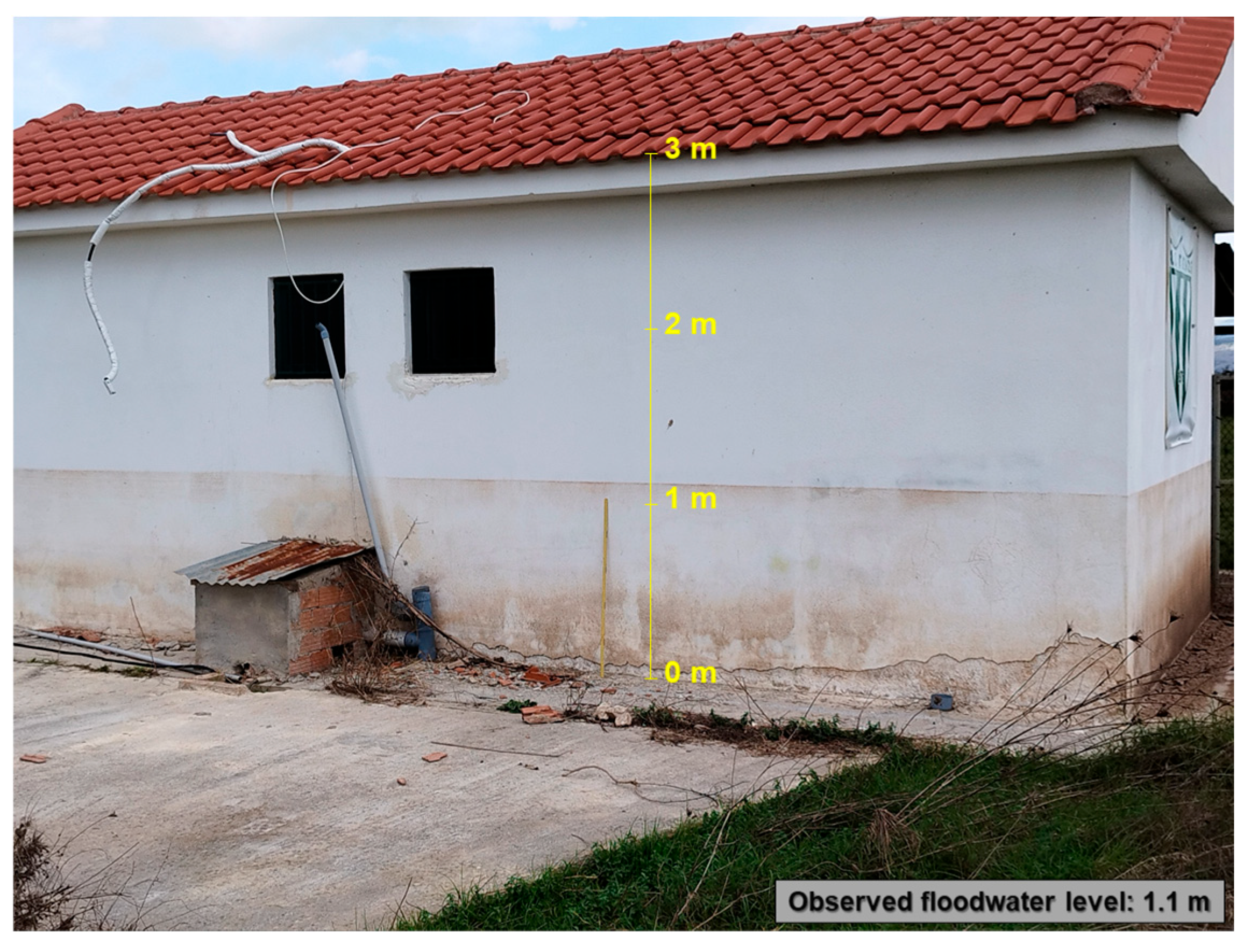
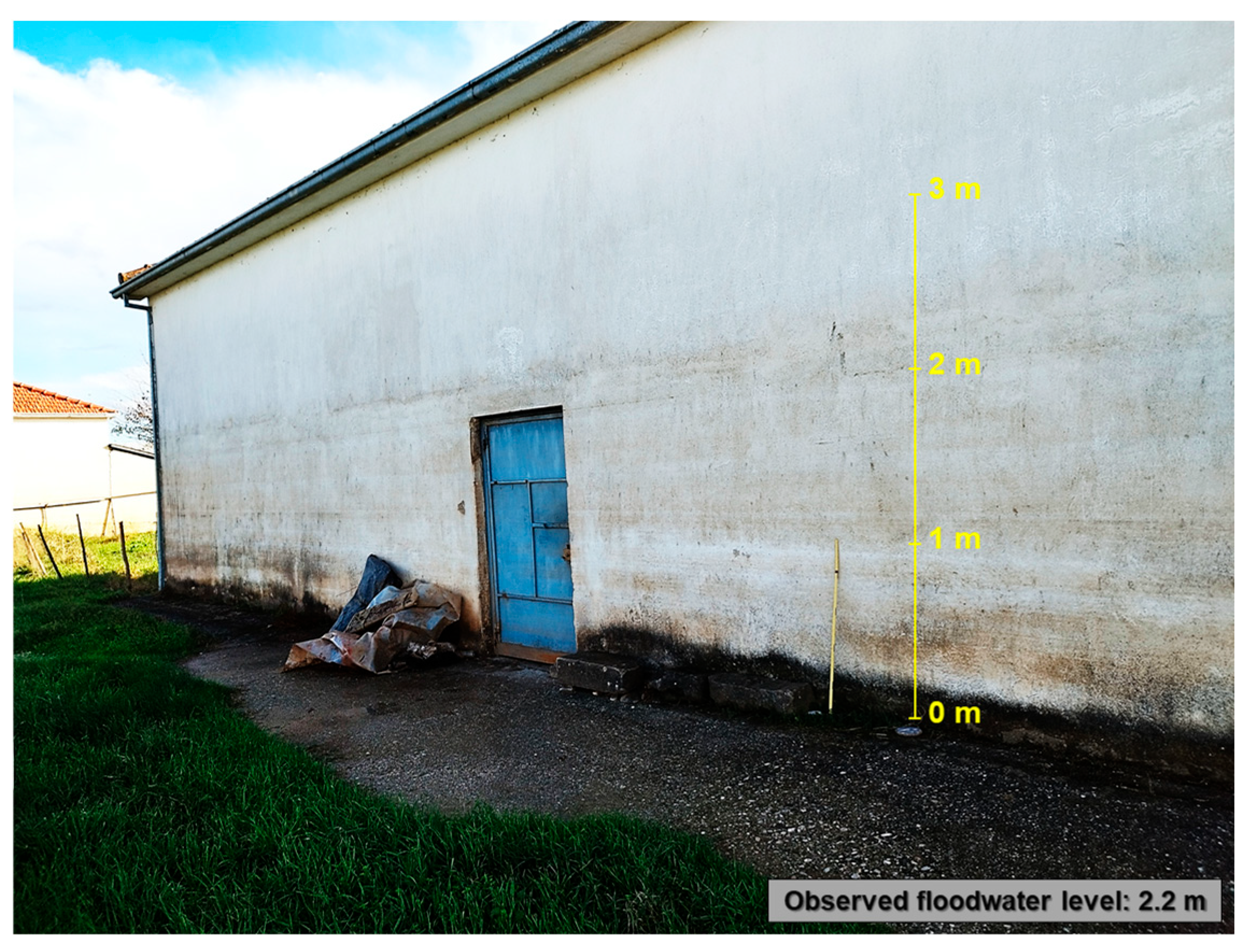
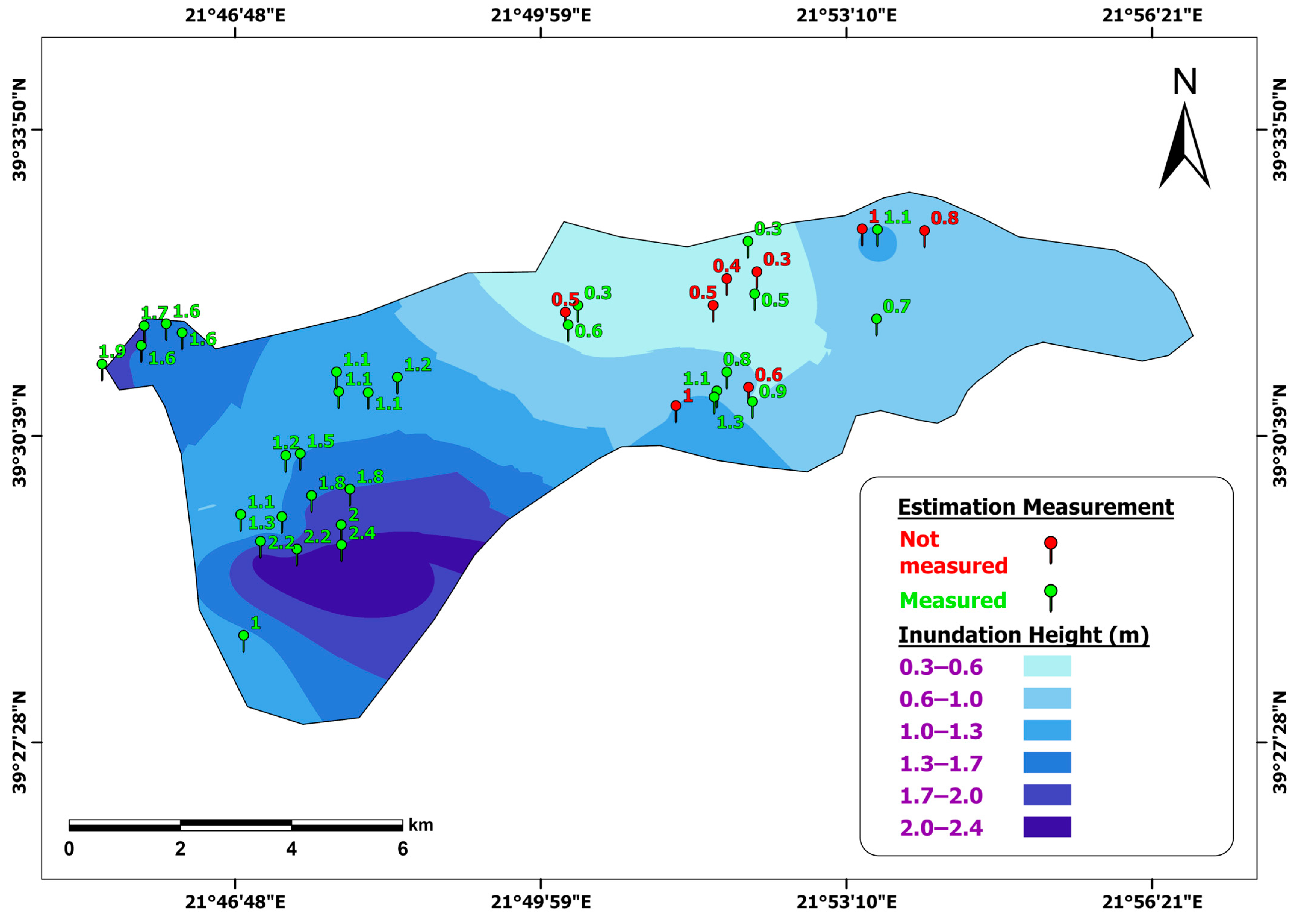
| Data | Resolution/Year | Source | Layer | Tool—Processing Through GIS |
|---|---|---|---|---|
| Hydrographic network | 2018 | [47] | Distance from rivers and channels–hydrographic density | Multiple ring buffer– line density |
| Bridge locations—confluence of river or channel locations | 300 m-buffer | Satellite imagery basemap of ArcGIS Pro | Distance from confluences of rivers or channels–distance from intersections between channels and roads | Create feature and buffer |
| Land use–land cover (LULC) | 10 m | [50] | Artificial and natural surfaces | Raster to polygon–clip and edit symbology |
| Digital elevation model (DEM) | 5 m | Digitization of topographic diagrams (1:5000, 5 m contour interval) of the Hellenic Military Geographical Service | Slope–elevation | Slope–edit symbology |
| Ranking | Description |
|---|---|
| 1 | Equal importance |
| 3 | Moderate importance |
| 5 | Strong or essential importance |
| 7 | Very strong importance |
| 9 | Extreme importance |
| 2,4,6,8 | Intermediate values |
| n | 1 | 2 | 3 | 4 | 5 | 6 | 7 | 8 | 9 |
|---|---|---|---|---|---|---|---|---|---|
| RI | 0 | 0 | 0.58 | 0.9 | 1.12 | 1.24 | 1.32 | 1.41 | 1.45 |
| Factor | Symbol | 5 | 4 | 3 | 2 | 1 |
|---|---|---|---|---|---|---|
| Distance from rivers and channels (m) | (a) | <300 | 300–600 | 600–900 | 900–1200 | >1200 |
| Distance from confluences of rivers or channels (m) | (b) | <2000 | - | - | - | >2000 |
| Drainage density (km/km2) | (c) | 6–9 | 4–6 | 2–4 | 1–2 | <1 |
| Distance from intersections between channels and roads (e.g., bridges) (m) | (d) | <300 | - | - | - | >300 |
| Land use–land cover (type) | (e) | Artificial surfaces | - | - | - | Natural surfaces |
| Slope (°) | (f) | <4 | 4–8 | 8–15 | 15–30 | >30 |
| Elevation (m) | (g) | 88–94 | 94–100 | 100–107 | 107–113 | >113 |
| Factor (n) | (a) | (b) | (c) | (d) | (e) | (f) | (g) |
|---|---|---|---|---|---|---|---|
| (a) | 1 | 1 | 2 | 2 | 4 | 4 | 6 |
| (b) | 1 | 1 | 1 | 2 | 3 | 5 | 6 |
| (c) | 1/2 | 1 | 1 | 2 | 5 | 6 | 7 |
| (d) | 1/2 | 1/2 | 1/2 | 1 | 3 | 4 | 5 |
| (e) | 1/4 | 1/3 | 1/5 | 1/3 | 1 | 3 | 4 |
| (f) | 1/4 | 1/5 | 1/6 | 1/4 | 1/3 | 1 | 2 |
| (g) | 1/6 | 1/6 | 1/7 | 1/5 | 1/4 | 1/2 | 1 |
| Total | 3.67 | 4.20 | 5.01 | 7.78 | 16.58 | 23.50 | 31.00 |
| n | (a) | (b) | (c) | (d) | (e) | (f) | (g) | wi | wi (%) | CA | RI | λ | CI | CR |
|---|---|---|---|---|---|---|---|---|---|---|---|---|---|---|
| (a) | 0.273 | 0.238 | 0.399 | 0.257 | 0.241 | 0.170 | 0.194 | 0.253 | 25.3 | 0.928 | 0 | 7.376 | 0.063 | 0.047 |
| (b) | 0.273 | 0.238 | 0.200 | 0.257 | 0.181 | 0.213 | 0.194 | 0.222 | 22.2 | 0.933 | 0 | |||
| (c) | 0.136 | 0.238 | 0.200 | 0.257 | 0.301 | 0.255 | 0.226 | 0.231 | 23.1 | 1.155 | 0.58 | |||
| (d) | 0.136 | 0.119 | 0.100 | 0.128 | 0.181 | 0.170 | 0.161 | 0.142 | 14.2 | 1.108 | 0.9 | |||
| (e) | 0.068 | 0.079 | 0.040 | 0.043 | 0.060 | 0.128 | 0.129 | 0.078 | 7.8 | 1.297 | 1.12 | |||
| (f) | 0.068 | 0.048 | 0.033 | 0.032 | 0.020 | 0.043 | 0.065 | 0.044 | 4.4 | 1.035 | 1.24 | |||
| (g) | 0.045 | 0.040 | 0.029 | 0.026 | 0.015 | 0.021 | 0.032 | 0.03 | 3.0 | 0.921 | 1.32 |
| FS Zones | Percentage of FS Map [100% of Study Area] | Percentage of Zones Flooded (2018) [14.3% of Study Area] | Percentage of Zones Flooded (2020) [16.3% of Study Area] | Percentage of Zones Flooded (2023) [45% of Study Area] |
|---|---|---|---|---|
| Very low | 8.90% | 1.19% | 4.07% | 7.05% |
| Low | 23.96% | 8.52% | 21.49% | 23.26% |
| Moderate | 20.64% | 18.59% | 23.65% | 23.78% |
| High | 24.63% | 35.41% | 29.75% | 24.16% |
| Very high | 21.87% | 36.29% | 21.99% | 21.75% |
Disclaimer/Publisher’s Note: The statements, opinions and data contained in all publications are solely those of the individual author(s) and contributor(s) and not of MDPI and/or the editor(s). MDPI and/or the editor(s) disclaim responsibility for any injury to people or property resulting from any ideas, methods, instructions or products referred to in the content. |
© 2025 by the authors. Licensee MDPI, Basel, Switzerland. This article is an open access article distributed under the terms and conditions of the Creative Commons Attribution (CC BY) license (https://creativecommons.org/licenses/by/4.0/).
Share and Cite
Alafostergios, N.; Evelpidou, N.; Spyrou, E. Flood Susceptibility Assessment Based on the Analytical Hierarchy Process (AHP) and Geographic Information Systems (GIS): A Case Study of the Broader Area of Megala Kalyvia, Thessaly, Greece. Information 2025, 16, 671. https://doi.org/10.3390/info16080671
Alafostergios N, Evelpidou N, Spyrou E. Flood Susceptibility Assessment Based on the Analytical Hierarchy Process (AHP) and Geographic Information Systems (GIS): A Case Study of the Broader Area of Megala Kalyvia, Thessaly, Greece. Information. 2025; 16(8):671. https://doi.org/10.3390/info16080671
Chicago/Turabian StyleAlafostergios, Nikolaos, Niki Evelpidou, and Evangelos Spyrou. 2025. "Flood Susceptibility Assessment Based on the Analytical Hierarchy Process (AHP) and Geographic Information Systems (GIS): A Case Study of the Broader Area of Megala Kalyvia, Thessaly, Greece" Information 16, no. 8: 671. https://doi.org/10.3390/info16080671
APA StyleAlafostergios, N., Evelpidou, N., & Spyrou, E. (2025). Flood Susceptibility Assessment Based on the Analytical Hierarchy Process (AHP) and Geographic Information Systems (GIS): A Case Study of the Broader Area of Megala Kalyvia, Thessaly, Greece. Information, 16(8), 671. https://doi.org/10.3390/info16080671








